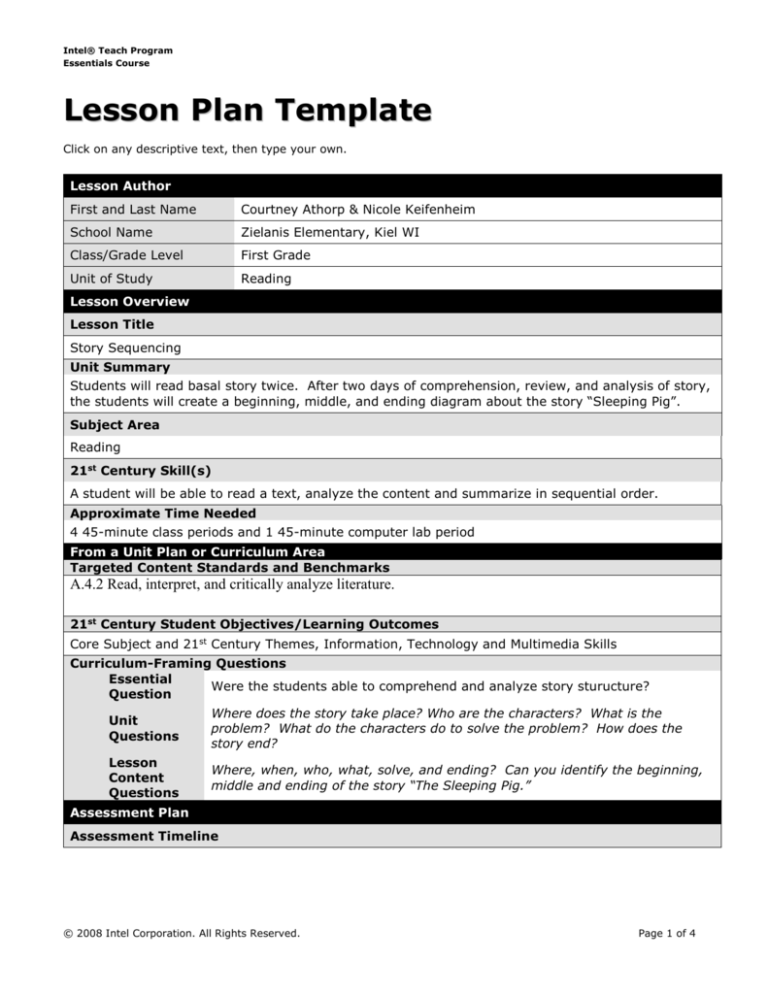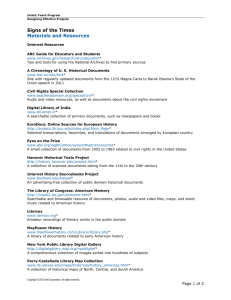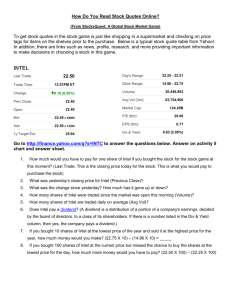
Intel® Teach Program
Essentials Course
Lesson Plan Template
Click on any descriptive text, then type your own.
Lesson Author
First and Last Name
Courtney Athorp & Nicole Keifenheim
School Name
Zielanis Elementary, Kiel WI
Class/Grade Level
First Grade
Unit of Study
Reading
Lesson Overview
Lesson Title
Story Sequencing
Unit Summary
Students will read basal story twice. After two days of comprehension, review, and analysis of story,
the students will create a beginning, middle, and ending diagram about the story “Sleeping Pig”.
Subject Area
Reading
21st Century Skill(s)
A student will be able to read a text, analyze the content and summarize in sequential order.
Approximate Time Needed
4 45-minute class periods and 1 45-minute computer lab period
From a Unit Plan or Curriculum Area
Targeted Content Standards and Benchmarks
A.4.2 Read, interpret, and critically analyze literature.
21st Century Student Objectives/Learning Outcomes
Core Subject and 21st Century Themes, Information, Technology and Multimedia Skills
Curriculum-Framing Questions
Essential
Were the students able to comprehend and analyze story sturucture?
Question
Unit
Questions
Where does the story take place? Who are the characters? What is the
problem? What do the characters do to solve the problem? How does the
story end?
Lesson
Content
Questions
Where, when, who, what, solve, and ending? Can you identify the beginning,
middle and ending of the story “The Sleeping Pig.”
Assessment Plan
Assessment Timeline
© 2008 Intel Corporation. All Rights Reserved.
Page 1 of 4
Intel® Teach Program
Essentials Course
Before project work begins
Asked
background
questions about
watermelons,
pigs, fruits,
vegetables.
Read through
and defined
vocabulary and
high-frequency
words
(practiced on
ipods during
guided
reading).
Defined and
practiced
onomatopoeia
words (sound
words) with the
students.
Had students
keep track of
what sounds or
ways the story
used to wake
the pig up.
Students work on projects
and complete tasks
Asked
After project work is
completed
Students created Classroom A:
Classroom B:
Used
Created a
Kidspiration and
beginning,
the students
middle, and
created a
ending story
beginning,
map using
middle, and
pencil and
ending poster
paper.
with sentences
that supported
Both classes
their visuals.
their own poster
comprehensio
on how they
n and critical
would wake the
thinking
sleeping pig and
questions to
wrote a
review story
sentence using
structure and
sound words.
understanding Students shared
.
work
Created a
story map
after reading
through the
story as a
class (on
Smartboard).
took a final
assessment of
skills for the
unit (paper and
pencil skills
assessment for
reading basal.
Assessment Summary
Each week the students will be introduced to the high-frequency words and several stories that will
provide background information to the basal story of the week. The students will practice these
words several times throughout the week with clap and chant and other ‘game’ like activities. When
background stories are introduced, the teacher will assess student background knowledge and
understanding of information begin provided. The students will be give daily journal prompts that
focus on the story of the week and the reading skill focus. Each day these journals are shared with
the teacher and other students. As the week progresses, the students will divulge into more specific
reading skills (this basal story’s focus was story structure and listening with purpose). Many
assessments happen as whole group or small group instruction. A story map on the Smartboard was
a whole group activity that reviewed story structure and story comprehension. Various workbook
pages were done individually that focused on these skills, which helped the teachers focus on areas
of need throughout the week. In addition, the students created their own ending to the story to
show understanding and creativity. The final assessment for this basal story was a beginning, middle
and ending poster where one group used the software program Kidspiration and another classroom
used paper and pencil. In addition, the students were given a spelling test on the high-frequency
words that were used throughout the week in various activities and on an ipod application (twice
during the week).
Lesson Details
Prerequisite Skills
The students must be able to read, use the Smartboard, ipods, and the software Kidspiration.
Instructional Procedures
The analysis of the story structure and comprehension is a concept covered throughout the entire
school year. This lesson is one of the many lessons throughout the year that cover this concept.
Therefore, the scope and sequence of the entire concept throughout the year would be beyond what
this question is looking for, but necessary to point out. Throughout the week, however, the basal
and our lessons do cover a scope and sequence within this larger picture. As mentioned above, we
provide background readings and high-frequency words that will give the students an understanding
© 2008 Intel Corporation. All Rights Reserved.
Page 2 of 4
Intel® Teach Program
Essentials Course
of the major story to come. We also use prior readings and our guided reading groups to make
further connections for the students on the comprehension strategy we are focusing on for the week.
Then, as we progress throughout the week, we incorporate various tools – questioning, group story
maps, writing prompts and journals. Our students understand what the goals of the week are
through direct discussion, written goals shared on the board, and through our guided reading groups.
The students reflect on their readings and evaluate if the book was easy or difficult and comment on
their progress after each reading. As teachers, we take this feedback into consideration and adjust
student reading levels, as we feel needed.
Accommodations for Differentiated Instruction
Special Needs
Students
At this time, we do not have any special needs students with IEPs, but
we do have varied learner levels within our classroom. These students
receive small group instruction with the classroom teacher, two thirty
minute sessions with our reading specialist, and another thirty minute
session with our other reading specialist during guided reading groups.
Nonnative
Speakers
At this time, we do not have any ELL students in our classroom. We do have
one student that is bilingual, but the student meets with the reading specialists
as mentioned above.
Gifted/Talented
Students
Our higher advanced readers are given the opportunity to work more
independently on assignments and readings. Then when we meet with small
groups, we review the comprehension strategies and provide independent
readings that will continue to challenge the students at a comfortable pace.
Materials and Resources Required For Lesson
Technology – Hardware (Click boxes of all equipment needed)
Camera
Laser Disk
VCR
Computer(s)
Printer
Video Camera
Digital Camera
Projection System
Video Conferencing Equip.
DVD Player
Scanner
Other ipods, Smartboard
Internet Connection
Television
Technology – Software (Click boxes of all software needed.)
Database/Spreadsheet
Image Processing
Web Page Development
Desktop Publishing
Internet Web Browser
Word Processing
E-mail Software
Multimedia
Other Kidspiration
Encyclopedia on CD-ROM
Printed Materials
Houghton Mifflin Reading Grade1, Houghton Mifflin Reading Guided
Workbooks, Daily Messages/ DOL from Smartboard, Beginning/Middle/
Ending Worksheet, printed product from Kidspiration, Spelling lists of highfrequency words
Supplies
Computers, laptops, ipods, Kidspiration Software, writing materials, colors
Internet Resources
www.itunes.com
Other Resources
For our control group we used another first grade class from Zielanis
Elementary, Kiel Area School District.
© 2008 Intel Corporation. All Rights Reserved.
Page 3 of 4
Intel® Teach Program
Essentials Course
Programs of the Intel® Education Initiative are funded by the Intel Foundation and Intel Corporation.
Copyright © 2007, Intel Corporation. All rights reserved. Intel, the Intel logo, Intel Education Initiative, and Intel Teach Program are
trademarks of Intel Corporation in the U.S. and other countries. *Other names and brands may be claimed as the property of others.
© 2000-2007 Intel Corporation. All Rights Reserved.
Page 4 of 4







